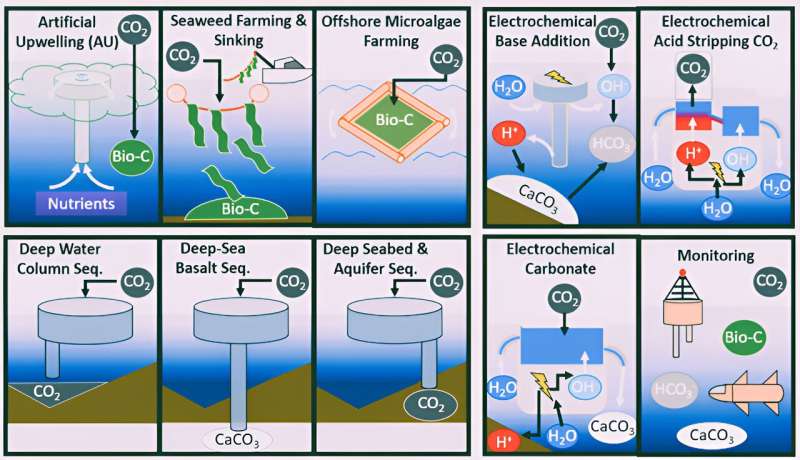

Can ocean energy power carbon removal?
source link: https://techxplore.com/news/2024-02-ocean-energy-power-carbon.html
Go to the source link to view the article. You can view the picture content, updated content and better typesetting reading experience. If the link is broken, please click the button below to view the snapshot at that time.

February 2, 2024
Can ocean energy power carbon removal?
by Caitlin McDermott-Murphy, National Renewable Energy Laboratory

The Caribbean has a problem, and it stinks.
Atop the Caribbean Sea's famously pristine waters floats a 5,000-mile-wide heap of rust-colored, brambly seaweed. When that seaweed, a form of sargassum, clumps up on beaches and decomposes, it emits hydrogen sulfide gas (also known as swamp gas), which smells like rotten eggs and, in high doses, can be toxic. For obvious reasons, this seaweed swarm is a huge problem for the Caribbean's tourism industry and residents—and potentially for Florida, where the heap is headed next.
But this stinky seaweed could also be part of a solution.
"If you sink that seaweed into the deep sea, you can potentially avoid those issues," James Niffenegger said. "And with seaweed sinking, the deeper you go, the longer you can store the carbon dioxide it absorbed from the air and water."
Niffenegger, a researcher at the National Renewable Energy Laboratory (NREL), is an author of a new study that examined various methods to capture carbon dioxide from the air or ocean and permanently sequester or store it—or, better yet, do both simultaneously.
These techniques—called marine carbon capture, marine carbon sequestration, and marine carbon dioxide removal—are almost as diverse as marine wildlife: Some involve farming or sinking seaweed, others inject captured carbon into deep-sea rocks, and some capitalize on clever chemistry to remove carbon directly from the ocean. But almost all are relatively new and untested technologies, and their costs, environmental impacts, and potential efficacy are still largely unstudied.
Until now.
For their study, Niffenegger and his colleagues—David Greene, Robert Thresher, and Michael Lawson—analyzed the benefits and drawbacks of each of the most promising marine carbon management techniques. But they also looked at how the country—and the world—could power these carbon-snatchers, especially those that operate in the remote ocean, far from any power grid.
The ocean, the team found, could be a valuable partner. Offshore energy technologies, including wind turbines and marine energy devices—which generate energy from ocean waves, currents, tides, and other watery power sources—could help meet global carbon removal goals. And they could do that with the energy available in U.S. waters alone.
"This is not a cure-all," Niffenegger said, meaning carbon removal alone cannot halt climate change.
Still, it is one remedy we can no longer do without.
A sinking ship: Why carbon removal is no longer optional
Like on-land carbon capture technologies, which can extract carbon from our air, marine carbon capture harvests the molecules from seawater or the air above. Carbon causes problems for both: Excess carbon dioxide gas in the atmosphere creates a kind of blanket around our world, trapping more heat as more carbon crams in. And even though the ocean absorbs a lot of that airborne carbon, those waters can only trap so much. Plus, too much carbon causes ocean acidification—a steady increase in seawater acidity—which puts marine ecosystems and wildlife at risk. Today, the ocean is basic, with a pH similar to baking soda.
"Basically, we're in a sinking ship now. Our boat is taking on water and we've got to plug up the holes," Niffenegger said. "But even after we plug up the holes, we've got to bail the water out. And if we take too long to do that, there might still be too much water in there for us to avoid the most significant impacts."
According to the Intergovernmental Panel on Climate Change, carbon dioxide removal is now essential to keep global warming to 1.5 degrees Celsius. If we cross that marker, today's climate change crises—superstorms, wildfires, floods, extreme droughts, lethal heat waves, crop devastation, and more—will only get worse.
To avoid those catastrophes (and their economic and human costs), the world needs to limit warming to 1.5°C by 2100. And to do that, we need to remove about 3 to 7 billion tons of carbon from our atmosphere per year by 2050. (For context, humans emitted about 40 billion tons of carbon dioxide in 2022 just by burning fossil fuels).
More information: Mission Analysis for Marine Renewable Energy To Provide Power for Marine Carbon Dioxide Removal. www.nrel.gov/docs/fy23osti/87165.pdf
Recommend
About Joyk
Aggregate valuable and interesting links.
Joyk means Joy of geeK